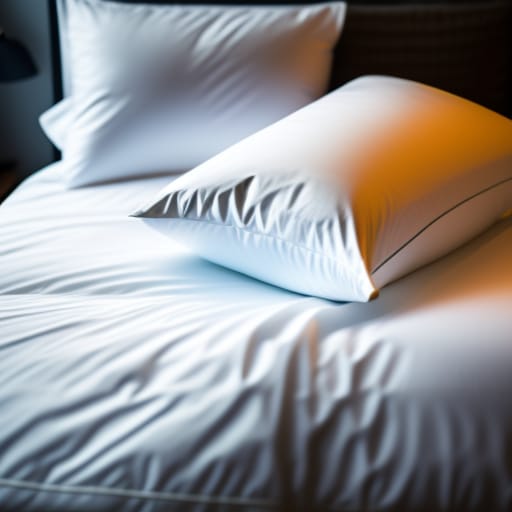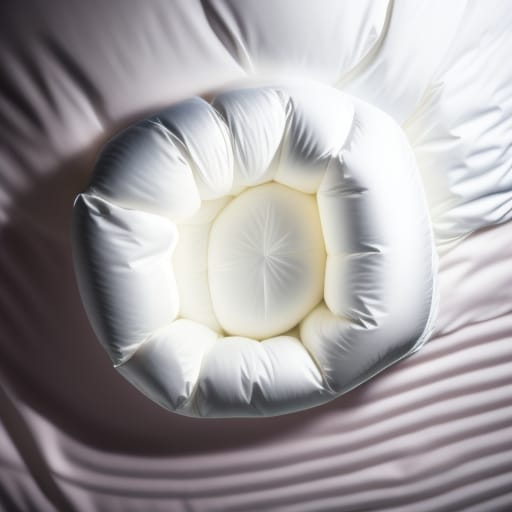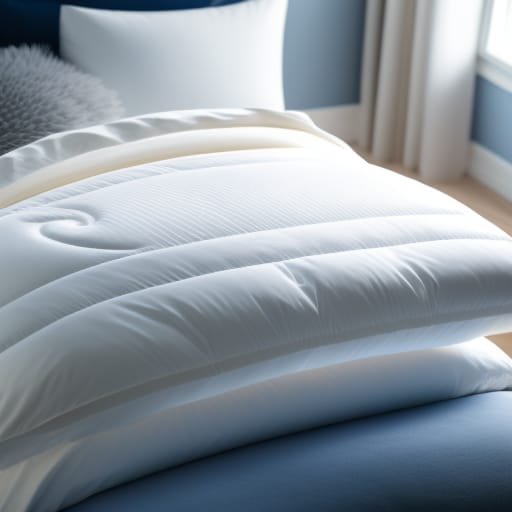Down duvets are one of the most luxurious and comfortable types of bedding available. But have you ever wondered exactly how these cozy, fluffy duvets are actually made?
In this comprehensive beginner’s guide, we’ll explore the fascinating down duvet manufacturing process from start to finish. You’ll learn all about how down is sourced, cleaned, sorted and processed, then stitched into duvets and prepared for sale. We’ll also cover key topics like down duvet production techniques, quality control, and innovations in manufacturing.
If you want to understand what goes into making an authentic, high-quality down duvet that will provide warmth and comfort for years to come, keep reading!
An Introduction to Down Duvets
Before we dive into the nitty-gritty details of down duvet production, let’s start with an overview of what exactly down duvets are and why they are so popular:
What Are Down Duvets?
A down duvet is a type of duvet or comforter filled with down feather stuffing. Down refers to the fine, fluffy clusters and plumules that come from underneath the feathers of ducks and geese. This natural down filling is what gives duvets their signature softness, fluffiness and ability to provide insulation.
Down duvets are usually covered with a duvet cover made from fabrics like cotton, linen or silk. The duvet insert can be used on its own, but the duvet cover protects the down and allows the insert to be easily washed.
Why Are Down Duvets So Popular?
Down duvets provide unmatched levels of comfort and warmth, which has made them a luxury bedding item prized all over the world. Here are some of the key benefits:
- Lightweight and breathable – The natural down filling creates plush loft while still allowing air to circulate, keeping sleepers warm in winter yet cool in summer.
- Molds to body shape – Down is very supple and shapes itself around the contours of the body for customized comfort and support.
- Long-lasting – High quality down duvets can last for 10-20 years with proper care. The down filling maintains resilience and insulation power.
- Warmth without weight – Down provides an exceptional warmth-to-weight ratio that cannot be matched by synthetic alternatives. Even lightweight down duvets provide cozy warmth.
- Hypoallergenic options available – For those allergic to down, duvets with hypoallergenic down alternative fills are available.
Down’s rare combination of softness, warmth, breathability and durability explains why down-filled bedding has been cherished for centuries and remains a hallmark of luxury today.
A Brief History of Down Duvets
The use of down as a filling material dates back centuries, across many cultures:
- Antiquity – Eiderdown, sourced from eider ducks, was used by ancient Romans and in traditional Nordic bedding.
- Middle Ages – European nobility slept under down duvets, establishing their association with luxury.
- Pioneer times – Settlers in North America relied on down duvets for survival in harsh winters.
- 20th century – Down duvets gained mass popularity as production became more advanced. They are now common in bedrooms across the world.
Down duvets have thus come a long way from their functional origins! Today, consumers can choose from a range of styles, sizes and fills to suit their comfort preferences.
Step 1: Selecting Materials – Sourcing High-Quality Down
The first step in manufacturing down duvets is obtaining the raw down material that will be used for filling. The quality and properties of the sourced down directly impacts the comfort, warmth and durability of the finished duvet.
Main Criteria for Selecting Down
The best down for duvets has the following characteristics:
- High loft – Ability to compress and spring back; creates fluffiness.
- Fill power – Indicates insulation capacity and warmth.
- Large clusters – Down pieces should be large and full, not broken.
- Cleanliness – Down must be washed to remove odors and debris.
- Ethical sourcing – From well-treated geese or ducks.
Fill power ranges from 300-900. Higher numbers indicate higher quality down with better loft and warmth. However, lower fill powers around 600 can still make nice, affordable duvets.
| Down Type | Fill Power | Price | Characteristics |
|---|---|---|---|
| Goose Down | 600-900 | $$$ | Fluffy, durable, warm |
| Duck Down | 300-700 | $ | Less lofty, affordable |
| Eiderdown | 700-900+ | $$$$ | Maximum loft and warmth |
Ethical Sourcing Practices
Reputable down suppliers adhere to standards like the Responsible Down Standard (RDS) which certifies that down is ethically sourced from ducks and geese that are:
- Provided with clean housing, food and water
- Handled and harvested using humane practices
- Never subjected to forced feeding or live-plucking
Ethical sourcing ensures the well-being of fowl while delivering higher quality down. Certifications like RDS offer consumer transparency and assurance.
Step 2: Processing Down – Cleaning and Sorting
Once sourced, raw down goes through multiple processing steps to prepare it for duvet filling:
Cleaning and Sterilization
Down straight off the duck or goose contains dust, dirt and natural impurities. It first undergoes intense washing cycles and sterilization to deep clean and disinfect it. Hot air drying then restores loft and fluffiness.
Sorting by Quality
Next, the cleaned down is sorted by experts into different quality grades based on:
- Fill power – Down is separated by insulation capacity. Higher grades have fuller clusters.
- Color – Whiter down is separated from darker shades.
- Cluster size – Larger clusters indicate higher quality and longevity.
- Foreign material – Any remaining feathers or debris are removed.
This meticulous sorting ensures only the highest quality down fills each duvet.
Treatment Processes
Additional processes can enhance down properties:
- Sanitization – Reduces allergens and irritants.
- Wet processing – Removes remaining oils to improve down cohesion.
- Tumbling – Separates and softens clusters to maximize loft.
Well-processed down optimized for fill power, cleanliness and longevity is now ready for the duvet manufacturing process!
Step 3: Manufacturing Down Duvets
Now we enter the production stage where the fluffy down filling is transformed into plush, comfortable down duvets.
1. Designing the Duvet Structure
Down duvet production begins with designing the underlying structure:
- The duvet dimensions are specified based on common mattress sizes.
- The shell fabric is chosen based on attributes like softness, breathability and durability. Popular options include cotton, Egyptian cotton, microfiber and silk.
- Baffle box construction – The shell is sectioned into fabric boxes that prevent the down from shifting. This allows even distribution.
- Corner loops are designed to attach the duvet to the cover.
2. Filling and Stitching the Duvet Shell
Now the manufacturing magic happens as the duvet shell is filled with down:
- The sorted down is weighed out to meet the specific fill weight for the duvet based on size and desired warmth rating. This is measured in grams per square meter (gsm).
- The down is fed into a computerized filling machine which distributes and partitions precise amounts into each baffle box through air blown injection.
- The openings of each baffle are then hand-sewn closed to prevent leakage.
- Edge stitching finalizes the duvet, sealing the outer shell.
The end result is a meticulously filled duvet with even distribution of down throughout its sections!
3. Quality Control and Finishing
The final phase involves inspections, testing and finishing:
- Fill power verification – Random samples are tested to confirm accurate fill power.
- Leakage inspection – Duvets are physically compressed and shaken to check for clustering and cold spots.
- Any duvets that fail to meet quality criteria are reworked before being approved.
- Finishing touches like duvet tags and packaging are added.
Thorough quality control ensures all duvets meet functionality and safety standards. They are now ready for shipment to retail stores!
Adaptations for Year-Round Use
Down duvets are expertly engineered not just for winter use but for year-round comfort. Here’s how they adapt:
Adjustable Warmth Ratings
The warmth rating or tog indicates the duvet’s level of insulation. This number ranges from 0.5 to 20+ and can be selected based on seasonal needs:
| Season | Recommended Tog Range |
|---|---|
| Summer | 2.5 – 4.5 tog |
| Spring/Fall | 7 – 10 tog |
| Winter | 10 – 15+ tog |
A lower tog provides breathability for warm weather while a higher tog adds cozy insulation for winter. Some duvets even allow you to adapt the tog by removing down layers.
Improved Breathability
Advancements in duvet engineering like:
- Baffle box construction to limit down shifting
- Lightweight shell fabrics like silk or linen
- Higher quality downs with improved loft
All allow optimal air circulation through the duvet. This keeps sleepers cool in summer yet still protected in winter.
Year-Round Comfort
With removable covers and adjustable warmth ratings, the same down duvet can be modified for use all year:
- Lightweight covers like crisp cottons in summer
- Heavier materials like flannel in winter
- Removing outer duvet layers when needed
Down duvets provide lasting value as your ideal sleep climate solution any time of year!

Caring for Your Down Duvet
To get the most out of your investment in a quality down duvet, proper care and maintenance are essential:
Use a Duvet Cover
Always keep your down duvet in a duvet cover to protect it from body oils and spills which can degrade the down. Duvet covers can easily be removed and washed.
Regular Cleaning
Down duvets should be professionally cleaned every 2-3 years to restore loft and ensure fill power. More frequent washing can damage down clusters.
Low Heat Drying
If your down duvet gets damp, dry it slowly on low heat to prevent the down from clumping. Never use high heat.
Proper Storage
Store duvets flat when not in use. Avoid compression which can damage the baffle walls. Use breathable storage like cotton duvet bags.
With the right care, your down duvet could last over a decade! Proper maintenance preserves the comfort and prolongs the life of this luxurious bedding investment.
Down Duvet Misconceptions – Debunked!
Despite their popularity, some common misconceptions still surround down duvets. Let’s clear up the facts:
Myth: All Down is the Same
Fact: There are massive quality differences that affect factors like durability, loft and warmth. Be sure to check the fill power, materials and certifications.
Myth: Down Duvets Are Only Warm
Fact: Thanks to adaptable togs and improved breathability, down duvets now provide year-round comfort.
Myth: Down Requires Special Cleaning
Fact: Most down duvets can now be machine washed and dried according to label instructions. However, professional cleaning every few years is still ideal.
Myth: Down Duvets Are Prone to Shifting
Fact: Baffle box construction prevents the filling from clumping or shifting. Higher quality downs have better clustering too.
Myth: Hypoallergenic Down Doesn’t Exist
Fact: Specific cleaning processes can remove up to 99% of allergens from down. Certified hypoallergenic options are available.
Now that you know the facts behind these common myths, you can better evaluate down duvets and find your perfect match!
Comparing Down Duvets to Other Bedding
How do down duvets stack up against other bedding options like comforters and blankets? Let’s evaluate the pros and cons.
Down vs. Synthetic Duvets
The main alternative to down is synthetic fills like polyester, microfiber or cotton. Here’s how they compare:
| Factor | Down Duvets | Synthetic Duvets |
|---|---|---|
| Warmth | Excellent – retains body heat | Good – mimic down properties |
| Fluffiness | Maximum loft, clusters re-fluff | Prone to clumping and flattening |
| Durability | 10-20 years if cared for | 5-10 years typical lifespan |
| Price | $$$ – $$$$ | $ – $$ More affordable |
| Allergies | Hypoallergenic options available | Generally hypoallergenic |
Whilesynthetic duvetshave improved greatly, down still provides unbeatable levels of longevity, breathability and resilience. However, synthetics can be a good budget option.
Down vs. Blankets
Compared to traditional blankets, key advantages of down duvets include:
- Adaptable warmth based on togs and covers
- Less shifting thanks to baffle boxes
- Customization to mattress size
- Ease of use with duvet covers
However, there is a certain nostalgic charm to blankets! Combining a light down duvet with a cozy blanket on top may be the best of both worlds.
The Nordic Tradition of Down Duvets
The luxurious heritage of down duvets traces back hundreds of years to cold Scandinavian winters. Here’s an overview:
History in Nordic Culture
- Down duvets originated in Scandinavia, where eiderdown was utilized by Vikings and Nordic royalty.
- They provided crucial insulation against frigid temperatures.
- Only the wealthy could afford down duvets, cementing their status as a luxury item.
- This reputation for comfort and exclusivity spread across Europe and abroad.
Specialization Across Europe
- Nordic countries like Hungary become renowned for artisanal, handmade down duvets.
- Other European nations specialized too: France in innovative duvet designs, Germany in precision manufacturing.
- This combined heritage of quality craftsmanship and technology still defines European down duvets.
While down duvets are now enjoyed worldwide, the Nordic essence of coziness and indulgence remains. Their luxurious legacy continues today.
Sustainability and Down Duvet Production
With growing eco-awareness, consumers are asking how down duvets impact the environment. Here are some sustainability facts.
Down Supply Chain Responsibility
Ethical, sustainable sourcing includes:
- Using all parts of waterfowl already processed for food
- Ensuring humane practices in raising and harvesting
- Supporting small farms instead of large factories
This reduces waste while respecting animal welfare.
Manufacturing Improvements
- New filling technology reduces down required per duvet.
- Investments in energy efficiency and renewables decrease carbon footprint.
- Some facilities now operate as Zero Waste.
Product Life Cycle and Recycling
- Biodegradable materials, like cotton and down itself, are favored.
- Retailers accept old duvets for professional recycling.
- Duvet components can also be re-purposed.
With innovative solutions, down duvets can deliver luxury comfort with less harm to the planet.

Down Duvet Market Trends and Consumers
Several key trends are shaping today’s down duvet market
Frequency Asked Questions
What is the difference between duck down and goose down?
Goose down tends to be higher quality than duck down. Goose down has larger clusters that provide better loft and durability. Goose down has a higher fill power, usually 600-900, while duck down is around 300-700. However, duck down is less expensive than goose down.
How often should I clean my down duvet?
It’s recommended to have your down duvet professionally cleaned every 2-3 years to revitalize the down and maintain fill power. You can spot clean small stains in between professional cleaning. Always check the manufacturer’s instructions for washing recommendations.
How do I know if a down duvet is high quality?
Check that the duvet has a high fill power of 600 or above. It should also have a thread count of 300 or higher. Press down on the duvet to check that it quickly springs back; this resiliency indicates good loft. High quality down duvets are also labeled with certifications like the Responsible Down Standard.
What’s the benefit of baffle box construction in a down duvet?
The baffle box design with segmented chambers prevents the down fill from shifting around inside the duvet. This provides an even distribution of down and avoids cold spots. Baffle boxes keep the fill in place for optimal insulation.
Can you use a down duvet in summer?
Yes, down duvets can be used year-round. Look for a lower tog rating around 3-5 tog for warm weather use. The lightweight fill and breathable construction prevent overheating while still providing cozy comfort. You can also remove duvet covers and use layers to adapt the warmth.








